Analysis of Australian Income Tax Law and Practice: Case Studies
VerifiedAdded on 2020/06/04
|9
|2772
|114
Report
AI Summary
This report provides a comprehensive analysis of Australian income tax law and practice, focusing on case studies and practical application. It begins with an introduction to Australian taxation, highlighting income tax as a primary revenue source and outlining the progressive tax structure. The report then delves into two significant case laws: FCT Vs Rowe (1997) and FCT Vs Stone (2005), detailing the facts, issues, and decisions of each case, with a focus on the concept of assessable income. The analysis extends to the case of Basil, examining his residential status under Australian tax law, considering domicile, the 183-day test, and superannuation. Furthermore, the report offers specific tax advice to Basil, addressing various income sources such as salary, rent subsidy, motor vehicle benefits, phone accounts, and holiday awards, as well as income from overseas sources including rent, dividends, and capital gains. The advice considers the relevant tax implications for each income type, referencing relevant sections of the Income Tax Assessment Act (ITAA) 1936 and 1997, and includes discussions of fringe benefits tax (FBT) and capital gains tax (CGT).
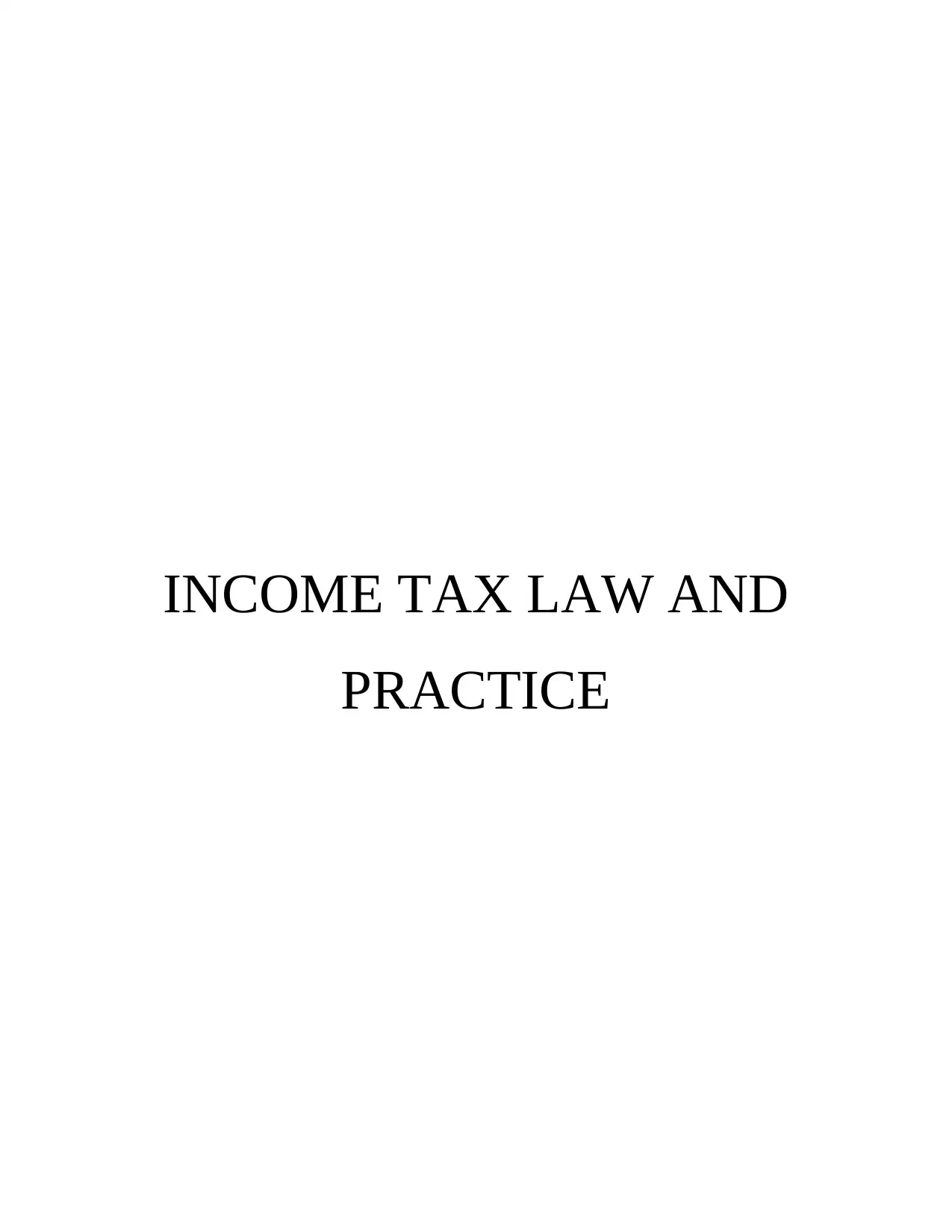
INCOME TAX LAW AND
PRACTICE
PRACTICE
Paraphrase This Document
Need a fresh take? Get an instant paraphrase of this document with our AI Paraphraser
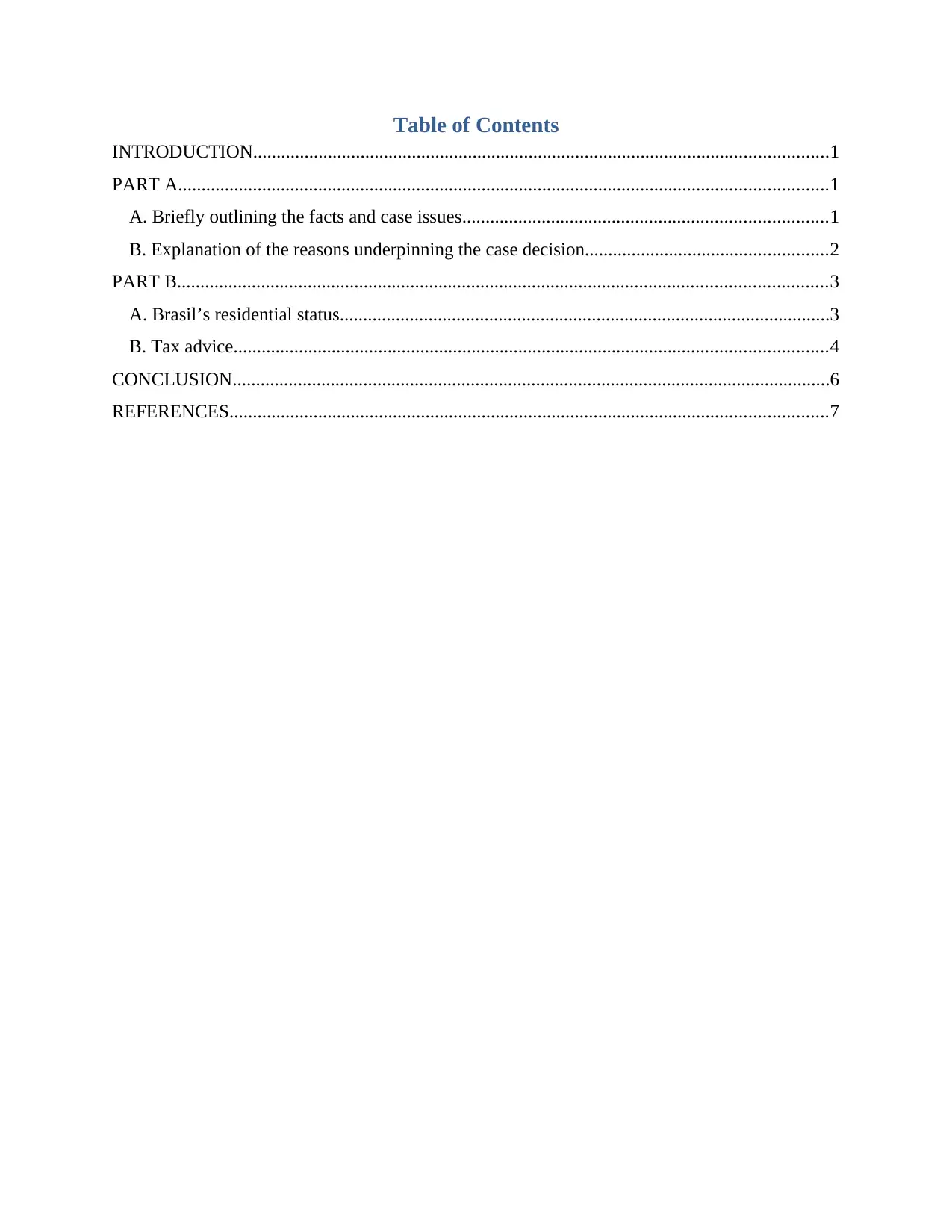
Table of Contents
INTRODUCTION...........................................................................................................................1
PART A...........................................................................................................................................1
A. Briefly outlining the facts and case issues..............................................................................1
B. Explanation of the reasons underpinning the case decision....................................................2
PART B...........................................................................................................................................3
A. Brasil’s residential status.........................................................................................................3
B. Tax advice...............................................................................................................................4
CONCLUSION................................................................................................................................6
REFERENCES................................................................................................................................7
INTRODUCTION...........................................................................................................................1
PART A...........................................................................................................................................1
A. Briefly outlining the facts and case issues..............................................................................1
B. Explanation of the reasons underpinning the case decision....................................................2
PART B...........................................................................................................................................3
A. Brasil’s residential status.........................................................................................................3
B. Tax advice...............................................................................................................................4
CONCLUSION................................................................................................................................6
REFERENCES................................................................................................................................7
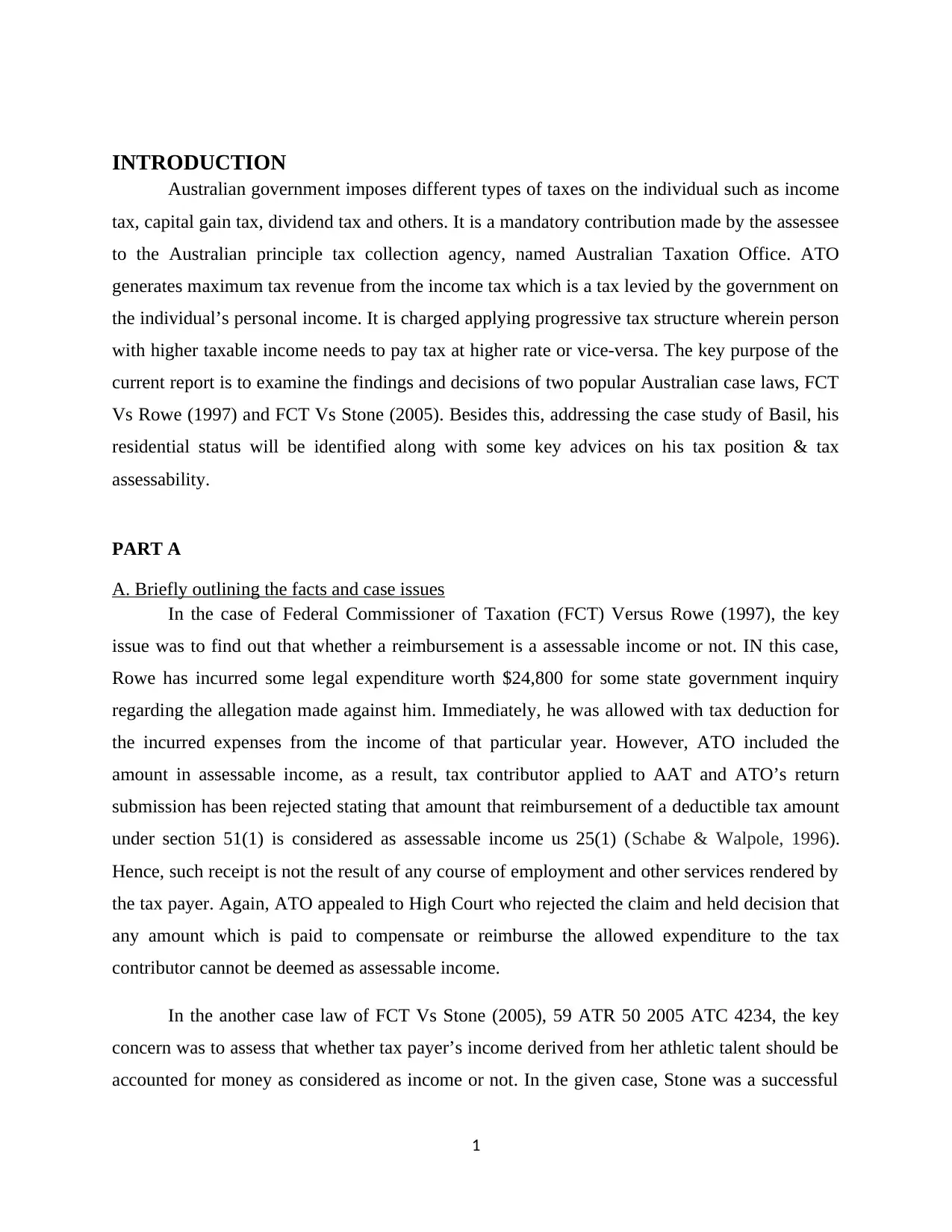
INTRODUCTION
Australian government imposes different types of taxes on the individual such as income
tax, capital gain tax, dividend tax and others. It is a mandatory contribution made by the assessee
to the Australian principle tax collection agency, named Australian Taxation Office. ATO
generates maximum tax revenue from the income tax which is a tax levied by the government on
the individual’s personal income. It is charged applying progressive tax structure wherein person
with higher taxable income needs to pay tax at higher rate or vice-versa. The key purpose of the
current report is to examine the findings and decisions of two popular Australian case laws, FCT
Vs Rowe (1997) and FCT Vs Stone (2005). Besides this, addressing the case study of Basil, his
residential status will be identified along with some key advices on his tax position & tax
assessability.
PART A
A. Briefly outlining the facts and case issues
In the case of Federal Commissioner of Taxation (FCT) Versus Rowe (1997), the key
issue was to find out that whether a reimbursement is a assessable income or not. IN this case,
Rowe has incurred some legal expenditure worth $24,800 for some state government inquiry
regarding the allegation made against him. Immediately, he was allowed with tax deduction for
the incurred expenses from the income of that particular year. However, ATO included the
amount in assessable income, as a result, tax contributor applied to AAT and ATO’s return
submission has been rejected stating that amount that reimbursement of a deductible tax amount
under section 51(1) is considered as assessable income us 25(1) (Schabe & Walpole, 1996).
Hence, such receipt is not the result of any course of employment and other services rendered by
the tax payer. Again, ATO appealed to High Court who rejected the claim and held decision that
any amount which is paid to compensate or reimburse the allowed expenditure to the tax
contributor cannot be deemed as assessable income.
In the another case law of FCT Vs Stone (2005), 59 ATR 50 2005 ATC 4234, the key
concern was to assess that whether tax payer’s income derived from her athletic talent should be
accounted for money as considered as income or not. In the given case, Stone was a successful
1
Australian government imposes different types of taxes on the individual such as income
tax, capital gain tax, dividend tax and others. It is a mandatory contribution made by the assessee
to the Australian principle tax collection agency, named Australian Taxation Office. ATO
generates maximum tax revenue from the income tax which is a tax levied by the government on
the individual’s personal income. It is charged applying progressive tax structure wherein person
with higher taxable income needs to pay tax at higher rate or vice-versa. The key purpose of the
current report is to examine the findings and decisions of two popular Australian case laws, FCT
Vs Rowe (1997) and FCT Vs Stone (2005). Besides this, addressing the case study of Basil, his
residential status will be identified along with some key advices on his tax position & tax
assessability.
PART A
A. Briefly outlining the facts and case issues
In the case of Federal Commissioner of Taxation (FCT) Versus Rowe (1997), the key
issue was to find out that whether a reimbursement is a assessable income or not. IN this case,
Rowe has incurred some legal expenditure worth $24,800 for some state government inquiry
regarding the allegation made against him. Immediately, he was allowed with tax deduction for
the incurred expenses from the income of that particular year. However, ATO included the
amount in assessable income, as a result, tax contributor applied to AAT and ATO’s return
submission has been rejected stating that amount that reimbursement of a deductible tax amount
under section 51(1) is considered as assessable income us 25(1) (Schabe & Walpole, 1996).
Hence, such receipt is not the result of any course of employment and other services rendered by
the tax payer. Again, ATO appealed to High Court who rejected the claim and held decision that
any amount which is paid to compensate or reimburse the allowed expenditure to the tax
contributor cannot be deemed as assessable income.
In the another case law of FCT Vs Stone (2005), 59 ATR 50 2005 ATC 4234, the key
concern was to assess that whether tax payer’s income derived from her athletic talent should be
accounted for money as considered as income or not. In the given case, Stone was a successful
1
⊘ This is a preview!⊘
Do you want full access?
Subscribe today to unlock all pages.

Trusted by 1+ million students worldwide
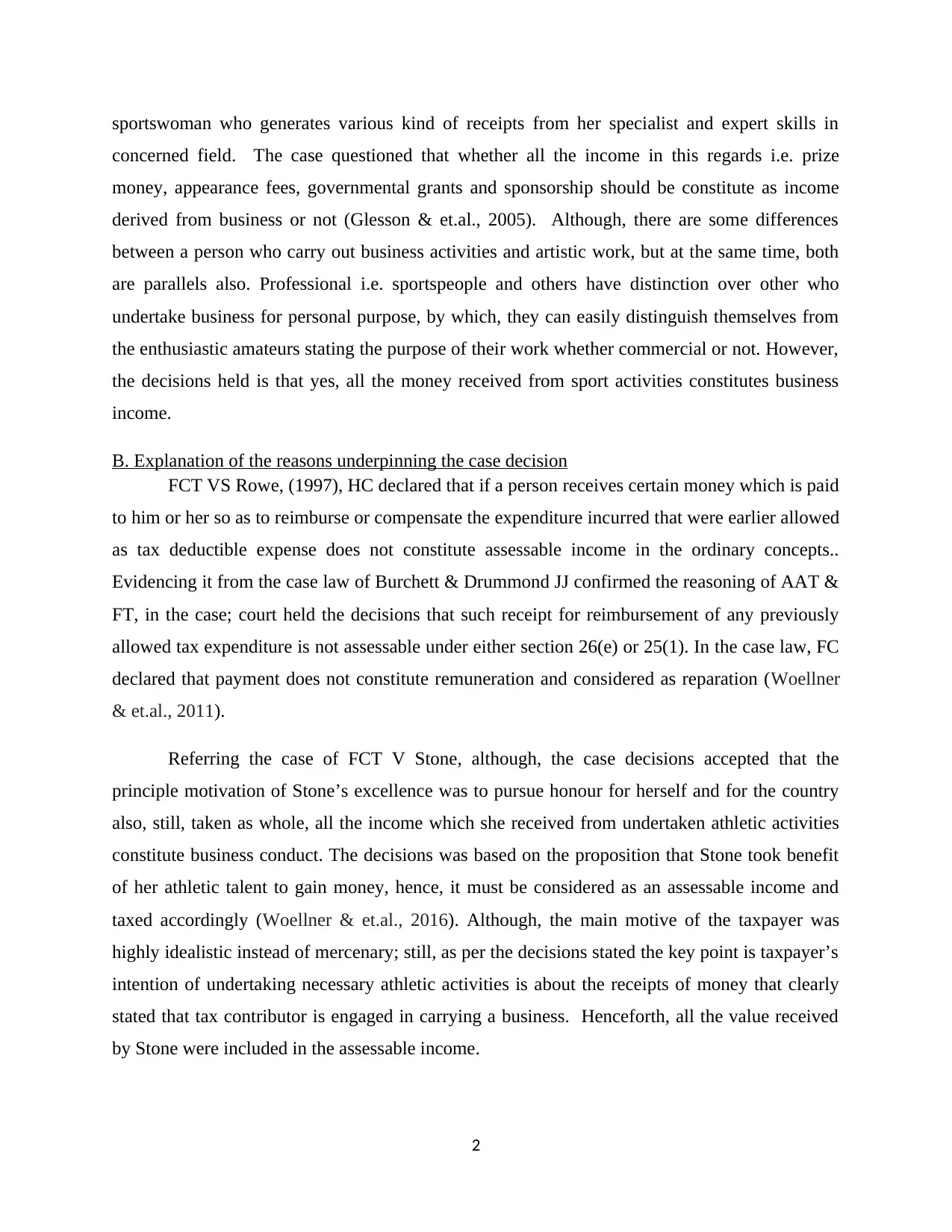
sportswoman who generates various kind of receipts from her specialist and expert skills in
concerned field. The case questioned that whether all the income in this regards i.e. prize
money, appearance fees, governmental grants and sponsorship should be constitute as income
derived from business or not (Glesson & et.al., 2005). Although, there are some differences
between a person who carry out business activities and artistic work, but at the same time, both
are parallels also. Professional i.e. sportspeople and others have distinction over other who
undertake business for personal purpose, by which, they can easily distinguish themselves from
the enthusiastic amateurs stating the purpose of their work whether commercial or not. However,
the decisions held is that yes, all the money received from sport activities constitutes business
income.
B. Explanation of the reasons underpinning the case decision
FCT VS Rowe, (1997), HC declared that if a person receives certain money which is paid
to him or her so as to reimburse or compensate the expenditure incurred that were earlier allowed
as tax deductible expense does not constitute assessable income in the ordinary concepts..
Evidencing it from the case law of Burchett & Drummond JJ confirmed the reasoning of AAT &
FT, in the case; court held the decisions that such receipt for reimbursement of any previously
allowed tax expenditure is not assessable under either section 26(e) or 25(1). In the case law, FC
declared that payment does not constitute remuneration and considered as reparation (Woellner
& et.al., 2011).
Referring the case of FCT V Stone, although, the case decisions accepted that the
principle motivation of Stone’s excellence was to pursue honour for herself and for the country
also, still, taken as whole, all the income which she received from undertaken athletic activities
constitute business conduct. The decisions was based on the proposition that Stone took benefit
of her athletic talent to gain money, hence, it must be considered as an assessable income and
taxed accordingly (Woellner & et.al., 2016). Although, the main motive of the taxpayer was
highly idealistic instead of mercenary; still, as per the decisions stated the key point is taxpayer’s
intention of undertaking necessary athletic activities is about the receipts of money that clearly
stated that tax contributor is engaged in carrying a business. Henceforth, all the value received
by Stone were included in the assessable income.
2
concerned field. The case questioned that whether all the income in this regards i.e. prize
money, appearance fees, governmental grants and sponsorship should be constitute as income
derived from business or not (Glesson & et.al., 2005). Although, there are some differences
between a person who carry out business activities and artistic work, but at the same time, both
are parallels also. Professional i.e. sportspeople and others have distinction over other who
undertake business for personal purpose, by which, they can easily distinguish themselves from
the enthusiastic amateurs stating the purpose of their work whether commercial or not. However,
the decisions held is that yes, all the money received from sport activities constitutes business
income.
B. Explanation of the reasons underpinning the case decision
FCT VS Rowe, (1997), HC declared that if a person receives certain money which is paid
to him or her so as to reimburse or compensate the expenditure incurred that were earlier allowed
as tax deductible expense does not constitute assessable income in the ordinary concepts..
Evidencing it from the case law of Burchett & Drummond JJ confirmed the reasoning of AAT &
FT, in the case; court held the decisions that such receipt for reimbursement of any previously
allowed tax expenditure is not assessable under either section 26(e) or 25(1). In the case law, FC
declared that payment does not constitute remuneration and considered as reparation (Woellner
& et.al., 2011).
Referring the case of FCT V Stone, although, the case decisions accepted that the
principle motivation of Stone’s excellence was to pursue honour for herself and for the country
also, still, taken as whole, all the income which she received from undertaken athletic activities
constitute business conduct. The decisions was based on the proposition that Stone took benefit
of her athletic talent to gain money, hence, it must be considered as an assessable income and
taxed accordingly (Woellner & et.al., 2016). Although, the main motive of the taxpayer was
highly idealistic instead of mercenary; still, as per the decisions stated the key point is taxpayer’s
intention of undertaking necessary athletic activities is about the receipts of money that clearly
stated that tax contributor is engaged in carrying a business. Henceforth, all the value received
by Stone were included in the assessable income.
2
Paraphrase This Document
Need a fresh take? Get an instant paraphrase of this document with our AI Paraphraser

PART B
A. Brasil’s residential status
The key concern of the provided case study is to find that whether Basil is an Australian
Resident for the purpose of tax or not. His residential position can be determined through
residency test addressing various sections of Australian Income Tax, ITAA A36, S6. In order to
determine his or her residential status, certain test can be applied including domicile test, 183 day
test & Commonwealth superannuation fund test. Referring the facts from the given case study,
the test is applied underneath:
Domicile test: According to the common law, ITAA 1936, s6(1), a person is considered
as an Australian resident if he or she domiciled in Australia, resides in Australia for the period of
more than half of the prevailing financial year or he or she is the member of Australian
Superannuation Fund (Mirrlees & James, 2010).
Applying the same test to the presented case, although Basil is domicile in England, still,
he came Australian with intend to reside in the country by obtaining a 3 year permit. Therefore,
he satisfied domicile test by and considered as Australian citizen under common law for the tax
purpose (Woellner & et.al., 2011). Evidencing it from the case law of FCT Vs Applegate (1979)
9 ATR 899, taxpayer did not considered as Australian resident because he did not reside in
Australia as a permanent place and went to Vila with his family on 8th Nov, 1971 and none of the
assets retained in the country. Likewise, referring from another case of FCT Vs Jenkins (1982)
12 ATR 745, it is stated that tax contributor was outside Australia for a period of more than 183
days in the given financial year therefore, he is not considered as Australian resident.
183 day test: As per ITAA 1936 S6(1), an individual must be reside in the country for
the time of more than half year. In the case, Basil is living continuously in Australia since 28th
June 2015 for the financial year 2015-16 for 307 days that is beyond 183 days. Henceforth, it
becomes clear that Basil satisfied the condition and will be considered as resident (Taylor &
Richardson, 2012.). He rented a house for accommodation and also looking for buying property
and real estate in Australia. CT Vs Cam & Sons Ltd (1936), assessee income some proportion of
revenues from New South Wales (NSW) and remainder outside NSW. Considering the working
time spent by him, it is declared that majority of the services performed outside NSW. Besides
3
A. Brasil’s residential status
The key concern of the provided case study is to find that whether Basil is an Australian
Resident for the purpose of tax or not. His residential position can be determined through
residency test addressing various sections of Australian Income Tax, ITAA A36, S6. In order to
determine his or her residential status, certain test can be applied including domicile test, 183 day
test & Commonwealth superannuation fund test. Referring the facts from the given case study,
the test is applied underneath:
Domicile test: According to the common law, ITAA 1936, s6(1), a person is considered
as an Australian resident if he or she domiciled in Australia, resides in Australia for the period of
more than half of the prevailing financial year or he or she is the member of Australian
Superannuation Fund (Mirrlees & James, 2010).
Applying the same test to the presented case, although Basil is domicile in England, still,
he came Australian with intend to reside in the country by obtaining a 3 year permit. Therefore,
he satisfied domicile test by and considered as Australian citizen under common law for the tax
purpose (Woellner & et.al., 2011). Evidencing it from the case law of FCT Vs Applegate (1979)
9 ATR 899, taxpayer did not considered as Australian resident because he did not reside in
Australia as a permanent place and went to Vila with his family on 8th Nov, 1971 and none of the
assets retained in the country. Likewise, referring from another case of FCT Vs Jenkins (1982)
12 ATR 745, it is stated that tax contributor was outside Australia for a period of more than 183
days in the given financial year therefore, he is not considered as Australian resident.
183 day test: As per ITAA 1936 S6(1), an individual must be reside in the country for
the time of more than half year. In the case, Basil is living continuously in Australia since 28th
June 2015 for the financial year 2015-16 for 307 days that is beyond 183 days. Henceforth, it
becomes clear that Basil satisfied the condition and will be considered as resident (Taylor &
Richardson, 2012.). He rented a house for accommodation and also looking for buying property
and real estate in Australia. CT Vs Cam & Sons Ltd (1936), assessee income some proportion of
revenues from New South Wales (NSW) and remainder outside NSW. Considering the working
time spent by him, it is declared that majority of the services performed outside NSW. Besides
3
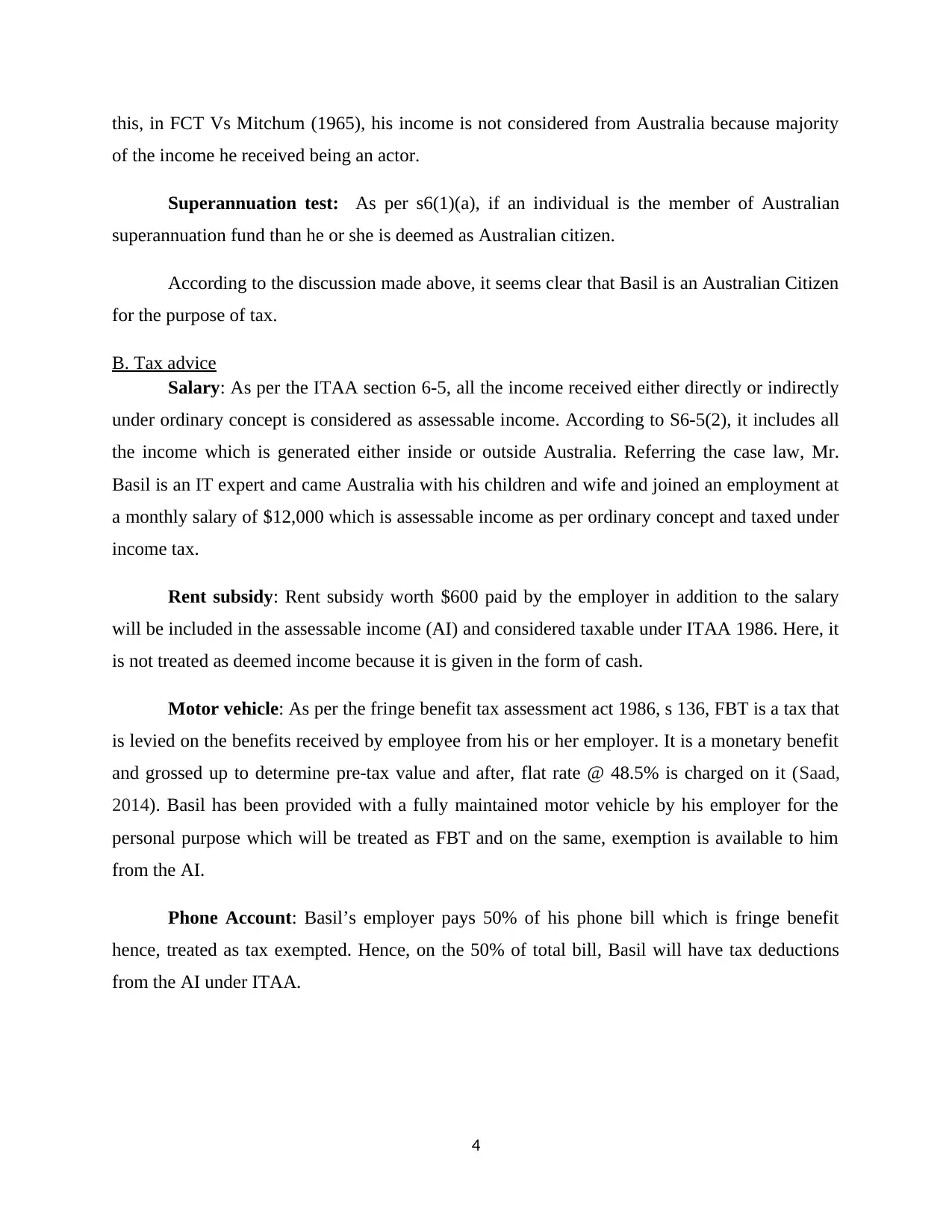
this, in FCT Vs Mitchum (1965), his income is not considered from Australia because majority
of the income he received being an actor.
Superannuation test: As per s6(1)(a), if an individual is the member of Australian
superannuation fund than he or she is deemed as Australian citizen.
According to the discussion made above, it seems clear that Basil is an Australian Citizen
for the purpose of tax.
B. Tax advice
Salary: As per the ITAA section 6-5, all the income received either directly or indirectly
under ordinary concept is considered as assessable income. According to S6-5(2), it includes all
the income which is generated either inside or outside Australia. Referring the case law, Mr.
Basil is an IT expert and came Australia with his children and wife and joined an employment at
a monthly salary of $12,000 which is assessable income as per ordinary concept and taxed under
income tax.
Rent subsidy: Rent subsidy worth $600 paid by the employer in addition to the salary
will be included in the assessable income (AI) and considered taxable under ITAA 1986. Here, it
is not treated as deemed income because it is given in the form of cash.
Motor vehicle: As per the fringe benefit tax assessment act 1986, s 136, FBT is a tax that
is levied on the benefits received by employee from his or her employer. It is a monetary benefit
and grossed up to determine pre-tax value and after, flat rate @ 48.5% is charged on it (Saad,
2014). Basil has been provided with a fully maintained motor vehicle by his employer for the
personal purpose which will be treated as FBT and on the same, exemption is available to him
from the AI.
Phone Account: Basil’s employer pays 50% of his phone bill which is fringe benefit
hence, treated as tax exempted. Hence, on the 50% of total bill, Basil will have tax deductions
from the AI under ITAA.
4
of the income he received being an actor.
Superannuation test: As per s6(1)(a), if an individual is the member of Australian
superannuation fund than he or she is deemed as Australian citizen.
According to the discussion made above, it seems clear that Basil is an Australian Citizen
for the purpose of tax.
B. Tax advice
Salary: As per the ITAA section 6-5, all the income received either directly or indirectly
under ordinary concept is considered as assessable income. According to S6-5(2), it includes all
the income which is generated either inside or outside Australia. Referring the case law, Mr.
Basil is an IT expert and came Australia with his children and wife and joined an employment at
a monthly salary of $12,000 which is assessable income as per ordinary concept and taxed under
income tax.
Rent subsidy: Rent subsidy worth $600 paid by the employer in addition to the salary
will be included in the assessable income (AI) and considered taxable under ITAA 1986. Here, it
is not treated as deemed income because it is given in the form of cash.
Motor vehicle: As per the fringe benefit tax assessment act 1986, s 136, FBT is a tax that
is levied on the benefits received by employee from his or her employer. It is a monetary benefit
and grossed up to determine pre-tax value and after, flat rate @ 48.5% is charged on it (Saad,
2014). Basil has been provided with a fully maintained motor vehicle by his employer for the
personal purpose which will be treated as FBT and on the same, exemption is available to him
from the AI.
Phone Account: Basil’s employer pays 50% of his phone bill which is fringe benefit
hence, treated as tax exempted. Hence, on the 50% of total bill, Basil will have tax deductions
from the AI under ITAA.
4
⊘ This is a preview!⊘
Do you want full access?
Subscribe today to unlock all pages.

Trusted by 1+ million students worldwide
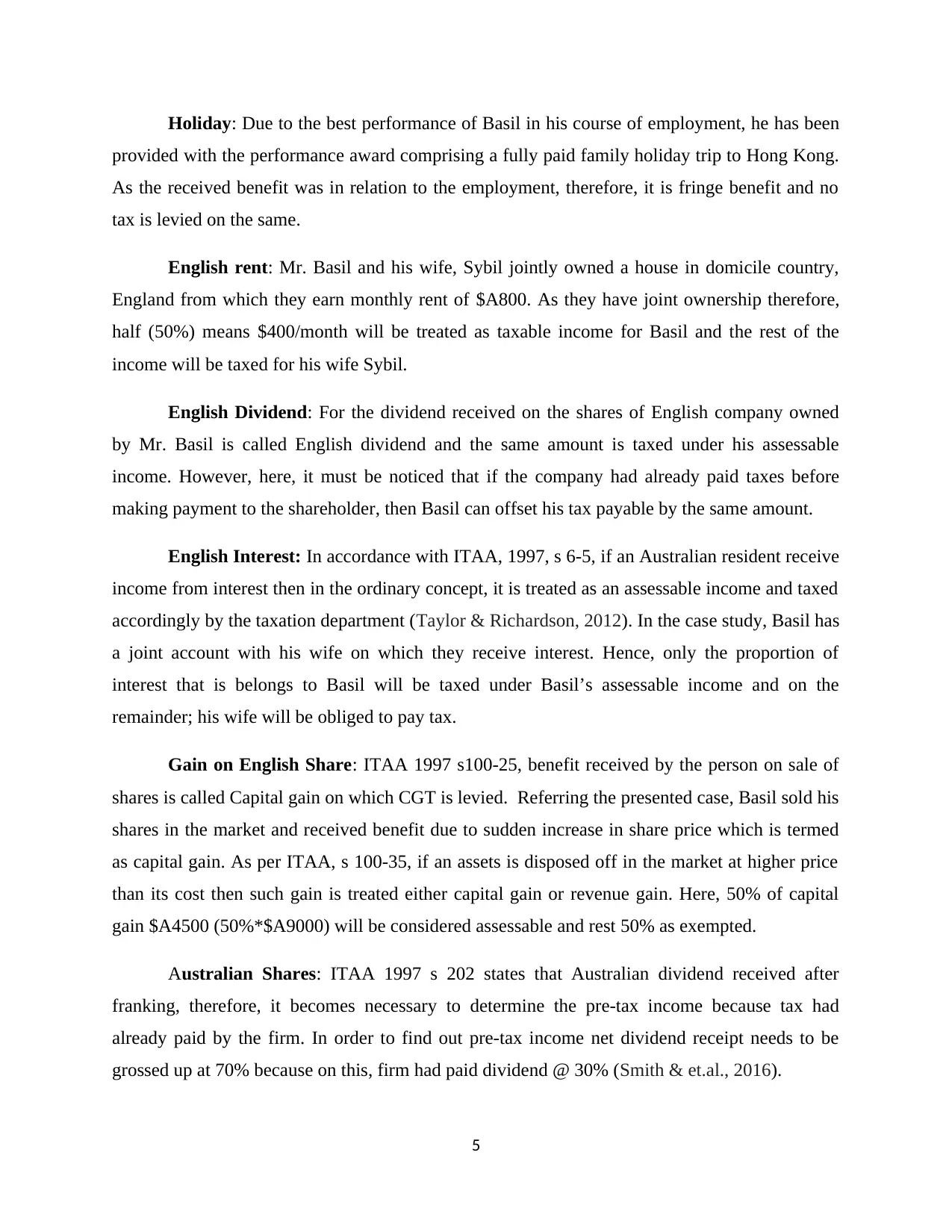
Holiday: Due to the best performance of Basil in his course of employment, he has been
provided with the performance award comprising a fully paid family holiday trip to Hong Kong.
As the received benefit was in relation to the employment, therefore, it is fringe benefit and no
tax is levied on the same.
English rent: Mr. Basil and his wife, Sybil jointly owned a house in domicile country,
England from which they earn monthly rent of $A800. As they have joint ownership therefore,
half (50%) means $400/month will be treated as taxable income for Basil and the rest of the
income will be taxed for his wife Sybil.
English Dividend: For the dividend received on the shares of English company owned
by Mr. Basil is called English dividend and the same amount is taxed under his assessable
income. However, here, it must be noticed that if the company had already paid taxes before
making payment to the shareholder, then Basil can offset his tax payable by the same amount.
English Interest: In accordance with ITAA, 1997, s 6-5, if an Australian resident receive
income from interest then in the ordinary concept, it is treated as an assessable income and taxed
accordingly by the taxation department (Taylor & Richardson, 2012). In the case study, Basil has
a joint account with his wife on which they receive interest. Hence, only the proportion of
interest that is belongs to Basil will be taxed under Basil’s assessable income and on the
remainder; his wife will be obliged to pay tax.
Gain on English Share: ITAA 1997 s100-25, benefit received by the person on sale of
shares is called Capital gain on which CGT is levied. Referring the presented case, Basil sold his
shares in the market and received benefit due to sudden increase in share price which is termed
as capital gain. As per ITAA, s 100-35, if an assets is disposed off in the market at higher price
than its cost then such gain is treated either capital gain or revenue gain. Here, 50% of capital
gain $A4500 (50%*$A9000) will be considered assessable and rest 50% as exempted.
Australian Shares: ITAA 1997 s 202 states that Australian dividend received after
franking, therefore, it becomes necessary to determine the pre-tax income because tax had
already paid by the firm. In order to find out pre-tax income net dividend receipt needs to be
grossed up at 70% because on this, firm had paid dividend @ 30% (Smith & et.al., 2016).
5
provided with the performance award comprising a fully paid family holiday trip to Hong Kong.
As the received benefit was in relation to the employment, therefore, it is fringe benefit and no
tax is levied on the same.
English rent: Mr. Basil and his wife, Sybil jointly owned a house in domicile country,
England from which they earn monthly rent of $A800. As they have joint ownership therefore,
half (50%) means $400/month will be treated as taxable income for Basil and the rest of the
income will be taxed for his wife Sybil.
English Dividend: For the dividend received on the shares of English company owned
by Mr. Basil is called English dividend and the same amount is taxed under his assessable
income. However, here, it must be noticed that if the company had already paid taxes before
making payment to the shareholder, then Basil can offset his tax payable by the same amount.
English Interest: In accordance with ITAA, 1997, s 6-5, if an Australian resident receive
income from interest then in the ordinary concept, it is treated as an assessable income and taxed
accordingly by the taxation department (Taylor & Richardson, 2012). In the case study, Basil has
a joint account with his wife on which they receive interest. Hence, only the proportion of
interest that is belongs to Basil will be taxed under Basil’s assessable income and on the
remainder; his wife will be obliged to pay tax.
Gain on English Share: ITAA 1997 s100-25, benefit received by the person on sale of
shares is called Capital gain on which CGT is levied. Referring the presented case, Basil sold his
shares in the market and received benefit due to sudden increase in share price which is termed
as capital gain. As per ITAA, s 100-35, if an assets is disposed off in the market at higher price
than its cost then such gain is treated either capital gain or revenue gain. Here, 50% of capital
gain $A4500 (50%*$A9000) will be considered assessable and rest 50% as exempted.
Australian Shares: ITAA 1997 s 202 states that Australian dividend received after
franking, therefore, it becomes necessary to determine the pre-tax income because tax had
already paid by the firm. In order to find out pre-tax income net dividend receipt needs to be
grossed up at 70% because on this, firm had paid dividend @ 30% (Smith & et.al., 2016).
5
Paraphrase This Document
Need a fresh take? Get an instant paraphrase of this document with our AI Paraphraser
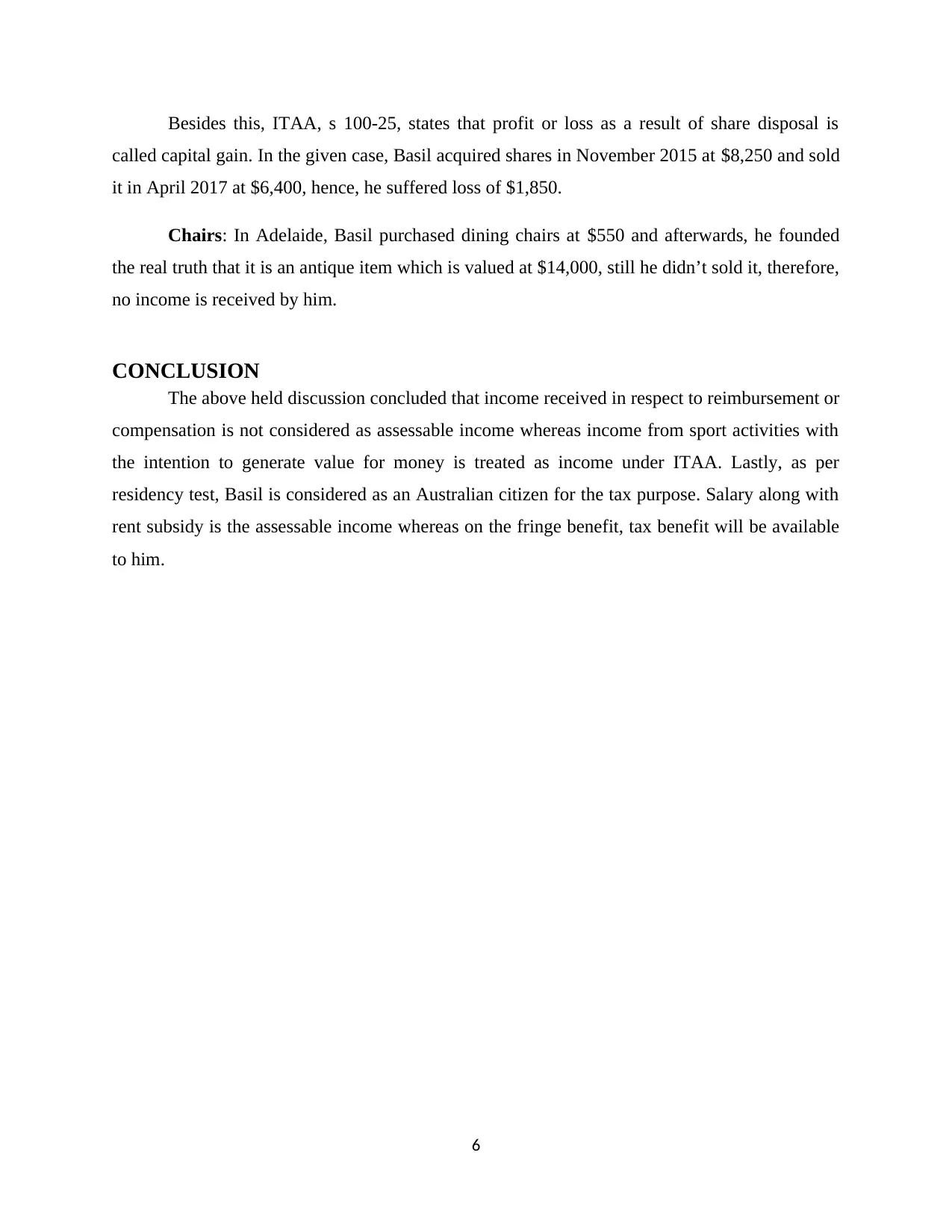
Besides this, ITAA, s 100-25, states that profit or loss as a result of share disposal is
called capital gain. In the given case, Basil acquired shares in November 2015 at $8,250 and sold
it in April 2017 at $6,400, hence, he suffered loss of $1,850.
Chairs: In Adelaide, Basil purchased dining chairs at $550 and afterwards, he founded
the real truth that it is an antique item which is valued at $14,000, still he didn’t sold it, therefore,
no income is received by him.
CONCLUSION
The above held discussion concluded that income received in respect to reimbursement or
compensation is not considered as assessable income whereas income from sport activities with
the intention to generate value for money is treated as income under ITAA. Lastly, as per
residency test, Basil is considered as an Australian citizen for the tax purpose. Salary along with
rent subsidy is the assessable income whereas on the fringe benefit, tax benefit will be available
to him.
6
called capital gain. In the given case, Basil acquired shares in November 2015 at $8,250 and sold
it in April 2017 at $6,400, hence, he suffered loss of $1,850.
Chairs: In Adelaide, Basil purchased dining chairs at $550 and afterwards, he founded
the real truth that it is an antique item which is valued at $14,000, still he didn’t sold it, therefore,
no income is received by him.
CONCLUSION
The above held discussion concluded that income received in respect to reimbursement or
compensation is not considered as assessable income whereas income from sport activities with
the intention to generate value for money is treated as income under ITAA. Lastly, as per
residency test, Basil is considered as an Australian citizen for the tax purpose. Salary along with
rent subsidy is the assessable income whereas on the fringe benefit, tax benefit will be available
to him.
6
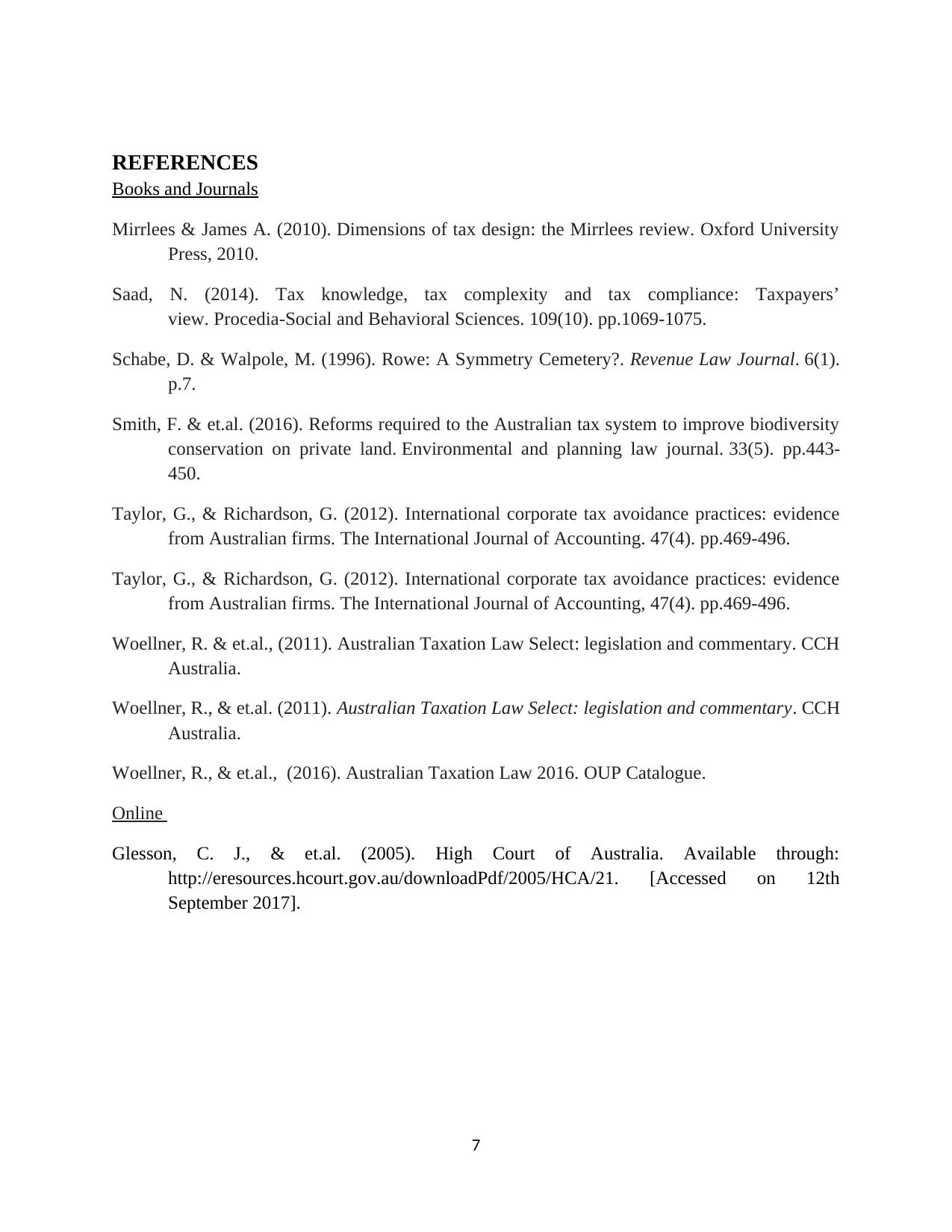
REFERENCES
Books and Journals
Mirrlees & James A. (2010). Dimensions of tax design: the Mirrlees review. Oxford University
Press, 2010.
Saad, N. (2014). Tax knowledge, tax complexity and tax compliance: Taxpayers’
view. Procedia-Social and Behavioral Sciences. 109(10). pp.1069-1075.
Schabe, D. & Walpole, M. (1996). Rowe: A Symmetry Cemetery?. Revenue Law Journal. 6(1).
p.7.
Smith, F. & et.al. (2016). Reforms required to the Australian tax system to improve biodiversity
conservation on private land. Environmental and planning law journal. 33(5). pp.443-
450.
Taylor, G., & Richardson, G. (2012). International corporate tax avoidance practices: evidence
from Australian firms. The International Journal of Accounting. 47(4). pp.469-496.
Taylor, G., & Richardson, G. (2012). International corporate tax avoidance practices: evidence
from Australian firms. The International Journal of Accounting, 47(4). pp.469-496.
Woellner, R. & et.al., (2011). Australian Taxation Law Select: legislation and commentary. CCH
Australia.
Woellner, R., & et.al. (2011). Australian Taxation Law Select: legislation and commentary. CCH
Australia.
Woellner, R., & et.al., (2016). Australian Taxation Law 2016. OUP Catalogue.
Online
Glesson, C. J., & et.al. (2005). High Court of Australia. Available through:
http://eresources.hcourt.gov.au/downloadPdf/2005/HCA/21. [Accessed on 12th
September 2017].
7
Books and Journals
Mirrlees & James A. (2010). Dimensions of tax design: the Mirrlees review. Oxford University
Press, 2010.
Saad, N. (2014). Tax knowledge, tax complexity and tax compliance: Taxpayers’
view. Procedia-Social and Behavioral Sciences. 109(10). pp.1069-1075.
Schabe, D. & Walpole, M. (1996). Rowe: A Symmetry Cemetery?. Revenue Law Journal. 6(1).
p.7.
Smith, F. & et.al. (2016). Reforms required to the Australian tax system to improve biodiversity
conservation on private land. Environmental and planning law journal. 33(5). pp.443-
450.
Taylor, G., & Richardson, G. (2012). International corporate tax avoidance practices: evidence
from Australian firms. The International Journal of Accounting. 47(4). pp.469-496.
Taylor, G., & Richardson, G. (2012). International corporate tax avoidance practices: evidence
from Australian firms. The International Journal of Accounting, 47(4). pp.469-496.
Woellner, R. & et.al., (2011). Australian Taxation Law Select: legislation and commentary. CCH
Australia.
Woellner, R., & et.al. (2011). Australian Taxation Law Select: legislation and commentary. CCH
Australia.
Woellner, R., & et.al., (2016). Australian Taxation Law 2016. OUP Catalogue.
Online
Glesson, C. J., & et.al. (2005). High Court of Australia. Available through:
http://eresources.hcourt.gov.au/downloadPdf/2005/HCA/21. [Accessed on 12th
September 2017].
7
⊘ This is a preview!⊘
Do you want full access?
Subscribe today to unlock all pages.

Trusted by 1+ million students worldwide
1 out of 9
Related Documents
Your All-in-One AI-Powered Toolkit for Academic Success.
+13062052269
info@desklib.com
Available 24*7 on WhatsApp / Email
![[object Object]](/_next/static/media/star-bottom.7253800d.svg)
Unlock your academic potential
Copyright © 2020–2025 A2Z Services. All Rights Reserved. Developed and managed by ZUCOL.





